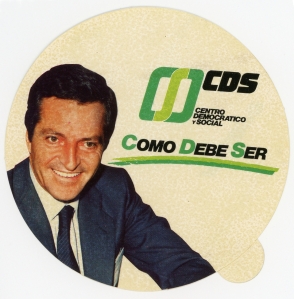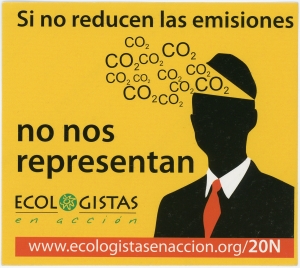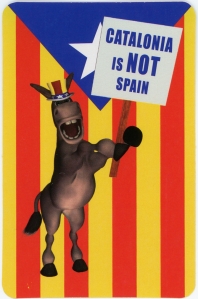New stickers from Spain for digital archive and writing assignment
- Published
- in all, Spain, Technology/2.0, the faith of graffiti
I haven’t had much time to post on Stickerkitty lately, but it doesn’t mean I haven’t been keeping busy with other things. I heard recently from SLU professor of modern languages, Marina Llorenta, that she’d like to repeat the assignment we created in 2012 to have her students conduct research on political stickers from Spain for her course on “Literature, Film, and Popular Culture in Contemporary Spain,” a project that later turned into an SLU art gallery exhibition called Pegatinas Políticas, which you can read about here. To prepare for the upcoming assignment this fall 2014 semester, I have been keeping an eye out for any sources from which I could acquire new Spanish stickers for her students to analyze. Last November, I contacted close to 30 Spanish political and grassroots organizations via their Facebook Web sites without much response. One group, the Popular Unity Movement Against Crisis, sent me 19 fantastic digital image files but didn’t send any physical items. Marina and I agreed we wanted the students to study the actual paper or vinyl stickers in real life, however, so my searching continued.
I’ve had much better luck finding Spanish stickers this spring. I contacted another SLU professor of modern languages, Steven White, who is currently in Madrid directing the SLU off-campus study program. He made contact with someone via eBay.es to help acquire a set of Spanish stickers dating from the late 1970s to present day (click here to view 31 stickers). A few of the 1970s stickers depict Adolfo Suárez, the first democratically elected prime minister of Spain after General Francisco Franco’s 41-year dictatorship. Suárez just passed away in March of 2014, and Steven thought perhaps that’s why these stickers appeared so recently on the market.
There are several Catalan independence movement stickers in the group, and from the same dealer we also acquired a set of eight historical stickers by the Direccion General de Juventud y Promocion Sociocultural that promoted the new Spanish Constitution of 1978. The sticker, Viva La Constitucion, La Soberania De España Reside En El Pueblo, means “Long Live The Constitution, The Sovereignty Of The People Living In Spain.”
Steven, a poet himself, is friends with the Spanish poet and sociologist Jorge Riechmann who helped contribute several stickers relating to current environmental issues. The sticker from Ecologistas En Acción (“Ecologists in Action”) states, Si No Reducen Las Emisiones, No Nos Representan,or “If You Do Not Reduce Emissions, Do Not Represent Us.” A total of 47 new stickers from Steven White and Jorge Riechmann can be viewed here.
Other stickers that have come in during the past couple of weeks represent various political parties and organizations, such as the Confederación Nacional del Trabajo (National Confederation of Labor), the Izquierda Anticapitalista (Anti-Capitalist Left), the Liga Estudantil Galega (Galician Students’ League), the Galiza Nova (the New Galicia), the Partido Comunista del Pueblo Castellano (Communist Party of the Castillian People? or Peoples of Spain?), and the Esquerda Unida (United Left). One can get a pretty good lesson in the range of Spanish political parties and Spanish autonomous communities by studying these stickers. Os Nosos Dereitos Non Se Recortan from the Esquerda Unida sticker below is Galician for “Our Rights Are Not Cut.”
And my sticker pal, Oli Baudach at Hatch Kingdom, is originally from Barcelona. He was there recently and sent me a bunch of new Catalan stickers. The one below depicts the Catalan donkey, a symbol often used in reaction to the Spanish symbol of the Osborne bull, superimposed on top of the red and yellow striped Senyera flag with a blue star, or Estelada blava of the Catalan independence movement.
All told and with the help of friends and others, there are now 139 new stickers from all over Spain dating from the 1970s to present day for Marina’s students to analyze and write about. I will fine-tune the assignment for the fall of 2014. Last time, we had the students write short essays of about 500 words each per sticker, as well as even shorter versions of about 150 words each that would be used as description fields or metadata for the Street Art Graphics digital archive. For some reason, the students often wrote two separate, unrelated pieces. Typically, they did a fine job contextualizing the historical and cultural content of the stickers, but not such a good job describing what was being depicted in each sticker and what those depictions signified. In that regard, some of the basic information for each sticker was missing. Cataloguing can be a challenge; one needs to identify the visual and textual elements, describe their significance, and outline the larger issues that are pointed to in each sticker.
As a side note, I recently discovered the Centro de Recuperación de Pegatinas, an Aragon-based center that has catalogued and archived over 40,000 Spanish stickers. They did posts on Adolfo Suárez, the miners’ march of 2012, and an exhibition of stickers related to Picasso’s Guernica painting, all of which feature stickers in my collection.





